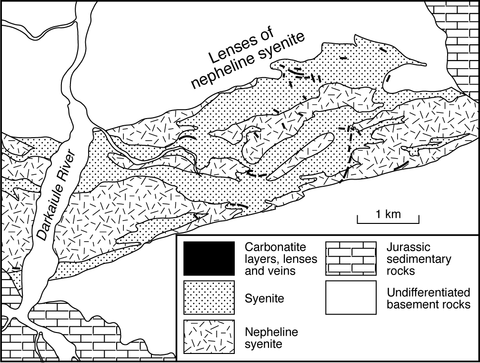stripes
This complex forms a steeply inclined sheet intruded into meta-rhyolites, biotite schists, amphibolites and rare marbles and is overlain and obscured by gently dipping Jurassic sediments. It has an overall length of about 35 km and a maximum outcrop width, in the central section, of nearly 3 km. The complex consists overwhelmingly of magmatic nepheline syenite and syenite which are cut by dykes and veins of nepheline syenite, muscovite syenite, nepheline syenite pegmatite, quartz syenite (aplite) and carbonatite. Metasomatised gneisses, which form about 5% of the oucrop (Gellatly and Hornung, 1968), are concentrated along some of the margins of the principal central outcrop, sporadically as rafts within it, and at the narrow northwestern extremity of the complex. The magmatic nepheline syenites are interbanded on a large scale (10s of metres) with syenites, but do not show the small-scale gneissic banding displayed by metasomatised gneisses. Although compositionally homogeneous they have poorly defined primary flow foliation of aligned biotite, feldspar and sometimes nepheline on which is superimposed a tectonic foliation that has re-orientated nepheline. A petrofabric study substantiating these observations is described by Gellatly (1964). The foliation is predominantly parallel to the contacts and the foliation of the surrounding basement rocks. The nepheline syenites are coarse rocks with albite (35%) and microcline (25%), which may be perthitic. Nepheline (about 25%) is commonly turbid and often intergrown with cancrinite, which may form rims against calcite; the nepheline may be completely altered to sericite. Green biotite is abundant (5-10%) with aegirine and magnesioriebeckite also plentiful. Accessories include zircon, garnet, magnetite, epidote, apatite and calcite with rare pyrochlore, molybdenite, pyrrhotite, pyrite and copper minerals. Irregularly distributed among, and grading into, the nepheline syenites, and developed by alteration of them (Gellatly, 1962), are syenites having the same accessory minerals with the more leucocratic varieties containing fine-grained muscovite pseudomorphs after nepheline. The metasomatic nepheline-bearing gneisses are of two types (Gellatly and Hornung, 1968): banded migmatitic gneiss and homogeneous non-migmatitic biotite-rich gneiss. The migmatitic gneiss consists of alternating bands of pale grey leucocratic biotite-nepheline-albite gneiss and dark grey biotite-rich andesine gneiss which may contain nepheline or cancrinite. The nepheline is altered everywhere except in the centres of leucocratic bands. The more homogeneous gneisses are strongly foliated, biotite-rich rocks with prominent grains of altered nepheline. Nepheline is less abundant than in the magmatic nepheline syenites with cancrinite the predominant feldspathoid; biotite, which is brown rather than green, is the only major mafic mineral. The feldspar is predominantly oligoclase-andesine with microcline <10% of the rock. Accessories include calcite, an opaque phase, apatite, zircon, allanite and pyrochlore, which is more abundant than in the magmatic nepheline syenites. Carbonatite occurs mainly as early bands and lenses, up to 300 m in length and 4 m thickness, which are concordent with the foliation of the enclosing rocks, but also as later discordent veins up to 30 m long and some 30 cm wide. They are mostly emplaced in syenite with only a few in nepheline syenite (Gellatly, 1963). There are also a few breccias of syenite blocks in a limonitic carbonatite matrix. Biotite selvages sometimes occur along contacts. The carbonatites are coarse rocks ranging from dark chocolate brown through rust brown and pink to white. They consist of dolomite and calcite with the former usually predominant and siderite identified in one specimen (Gellatly, 1963). Biotite is the only other major mineral with accessories including apatite, magnetite, barite, quartz and graphite. The last mineral and its paragenesis is discussed by Gellatly (1966). Two steeply dipping concordent sheets of limonitic carbonatite described by Gellatly et al. (1971) contain aggregates of powellite up to a centimetre across which apparently pseudomorph molybdenite. Dykes and veins of nepheline syenite pegmatite occur throughout the nepheline syenites and consist mainly of albite, microcline and nepheline with some biotite and may contain scattered flakes of molybdenite. Analyses of magmatic and metasomatic nepheline syenites are given in Gellatly and Hornung (1968) and Gellatly et al. (1971) give Mo determinations for a range of rocks.
ALLEN, J.B. and CHARSLEY, T.J. 1968. Nepheline-syenite and phonolite. Institute of Geological Sciences, Mineral Resources Division. London. 169 pp.GELLATLY, D.C. 1962. A preliminary note on the Darkainle alkaline complex, Borama District, Somali Republic. Annual Report, Research Institute of African Geology, University of Leeds, 6: 22-3. GELLATLY, D.C. 1963. Carbonatites of the Darkainle alkaline complex, Somali Republic. Annual Report, Research Institute of African Geology, University of Leeds, 7: 15-7.GELLATLY, D.C. 1964. Nepheline and feldspar orientations in nepheline syenites from Darkainle, Somali Republic. American Journal of Science, 262: 635-42.GELLATLY, D.C. 1966. Graphite in natural and experimental carbonate systems. Mineralogical Magazine, 35: 963-70.GELLATLY, D.C. and HORNUNG, G. 1968. Metasomatic nepheline-bearing gneisses from Darkainle, Somali Republic. Journal of Geology, 76: 678-91.GELLATLY, D.C., DANIELS, J.L. and ROOKE, J.M. 1971. Molybdenum in carbonatite and associated alkaline rocks from Darkainle, Somali Republic. Overseas Geology and Mineral Resources, Institute of Geological Sciences, 10: 328-36.

